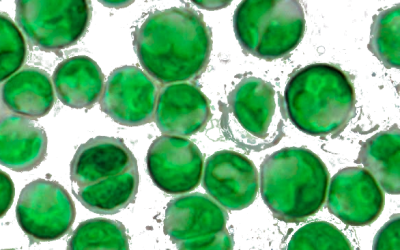Why develop new biofuel production strains?

The microalgal cell is the most important component of the algal bio-oil production system. Its photosynthetic and metabolic capabilities define the operational limits of biomass and triacylglyceride synthesis which controls bio-oil productivity. Microalgae are tremendously diverse and have expanded to occupy every terrestrial, freshwater and marine environment capable of supporting photoautotrophic metabolism of [1,23]. Despite, however, the huge microalgal biodiversity available, which is estimated to number over a million species [1,3, screening for industrialbioenergy carbon capture (BECC) strains has been limited limited in scale and largely confined to screens of pre-existing academic culture collections which number less than 30,000 strains [4,5,6,7,8]. Performance testing in large scale biofuel programmes has therefore been limited to Chlorella, Desmodesmus, Monoraphidium, Scenedesmus and Nannochloropsis strains which respond poorly to abiotic and biotic stresses leading to very low biomass production and lipid content [9, 10.
To address this fundamental limitation, new strains with higher real-world triacylglyceride productivity are required that can operate efficiently under the multiple abiotic stresses experienced during industrial scale culture. Therefore, a key element in HutanBio’s successful technology is our strain library.
Our bioprospecting programme succesfully generated an industrial strain library of over 400 physiologically robust, high biomass, fast-growing marine microalgae that thrive under high light, temperature and salinity abiotic stressors as well as exhibit resistance to biotic stressors. This is the largest and best characterised tropical marine industrial microalgae strain library available. These strains provide productivity with high abiotic and biotic stress tolerance.
(1) Fukuda, S.; Hirasawa, E.; Takemura, T.; Takahashi, S.; Chokshi, K.; Pancha, I.; Tanaka, K.; Imamura, S. Accelerated Triacylglycerol Production without Growth Inhibition by Overexpression of a Glycerol-3-Phosphate Acyltransferase in the Unicellular Red Alga Cyanidioschyzon Merolae. Sci. Rep. 2018, 8 (1), 12410. https://doi.org/10.1038/s41598-018-30809-8.
(2) Kumar, G.; Shekh, A.; Jakhu, S.; Sharma, Y.; Kapoor, R.; Sharma, T. R. Bioengineering of Microalgae: Recent Advances, Perspectives, and Regulatory Challenges for Industrial Application. Front. Bioeng. Biotechnol. 2020, 0, 914. https://doi.org/10.3389/FBIOE.2020.00914.
(3) Yuan, J.; Kendall, A.; Zhang, Y. Mass Balance and Life Cycle Assessment of Biodiesel from Microalgae Incorporated with Nutrient Recycling Options and Technology Uncertainties. GCB Bioenergy 2015, 7 (6), 1245–1259. https://doi.org/10.1111/GCBB.12229.
(4) Mooney, B. P.; Miernyk, J. A.; Randall, D. D. Cloning and Characterization of the Dihydrolipoamide S-Acetyltransferase Subunit of the Plastid Pyruvate Dehydrogenase Complex (E2) from Arabidopsis. Plant Physiol. 1999, 120 (2), 443. https://doi.org/10.1104/PP.120.2.443.
(5) O, A.; A, B.; I, R.; U, P. Enhanced Acetyl-CoA Production Is Associated with Increased Triglyceride Accumulation in the Green Alga Chlorella Desiccata. J. Exp. Bot. 2015, 66 (13), 3725–3735. https://doi.org/10.1093/JXB/ERV166.
(6) Miller, R.; Wu, G.; Deshpande, R. R.; Vieler, A.; Gärtner, K.; Li, X.; Moellering, E. R.; Zäuner, S.; Cornish, A. J.; Liu, B.; Bullard, B.; Sears, B. B.; Kuo, M.-H.; Hegg, E. L.; Shachar-Hill, Y.; Shiu, S.-H.; Benning, C. Changes in Transcript Abundance in Chlamydomonas Reinhardtii Following Nitrogen Deprivation Predict Diversion of Metabolism. Plant Physiol. 2010, 154 (4), 1737–1752. https://doi.org/10.1104/PP.110.165159.
(7) Shtaida, N.; Khozin-Goldberg, I.; Boussiba, S. The Role of Pyruvate Hub Enzymes in Supplying Carbon Precursors for Fatty Acid Synthesis in Photosynthetic Microalgae. Photosynthesis Research. Kluwer Academic Publishers September 17, 2015, pp 407–422. https://doi.org/10.1007/s11120-015-0136-7.
(8) Li-Beisson, Y.; Thelen, J. J.; Fedosejevs, E.; Harwood, J. L. The Lipid Biochemistry of Eukaryotic Algae. Progress in Lipid Research. Elsevier Ltd April 1, 2019, pp 31–68. https://doi.org/10.1016/j.plipres.2019.01.003.
(9) Hu, Q.; Sommerfeld, M.; Jarvis, E.; Ghirardi, M.; Posewitz, M.; Seibert, M.; Darzins, A. Microalgal Triacylglycerols as Feedstocks for Biofuel Production: Perspectives and Advances. Plant Journal. May 2008, pp 621–639. https://doi.org/10.1111/j.1365-313X.2008.03492.x.
(10) Chen, J. W.; Liu, W. J.; Hu, D. X.; Wang, X.; Balamurugan, S.; Alimujiang, A.; Yang, W. D.; Liu, J. S.; Li, H. Y. Identification of a Malonyl CoA-Acyl Carrier Protein Transacylase and Its Regulatory Role in Fatty Acid Biosynthesis in Oleaginous Microalga Nannochloropsis Oceanica. Biotechnol. Appl. Biochem. 2017, 64 (5), 620–626. https://doi.org/10.1002/bab.1531.

Recent Comments